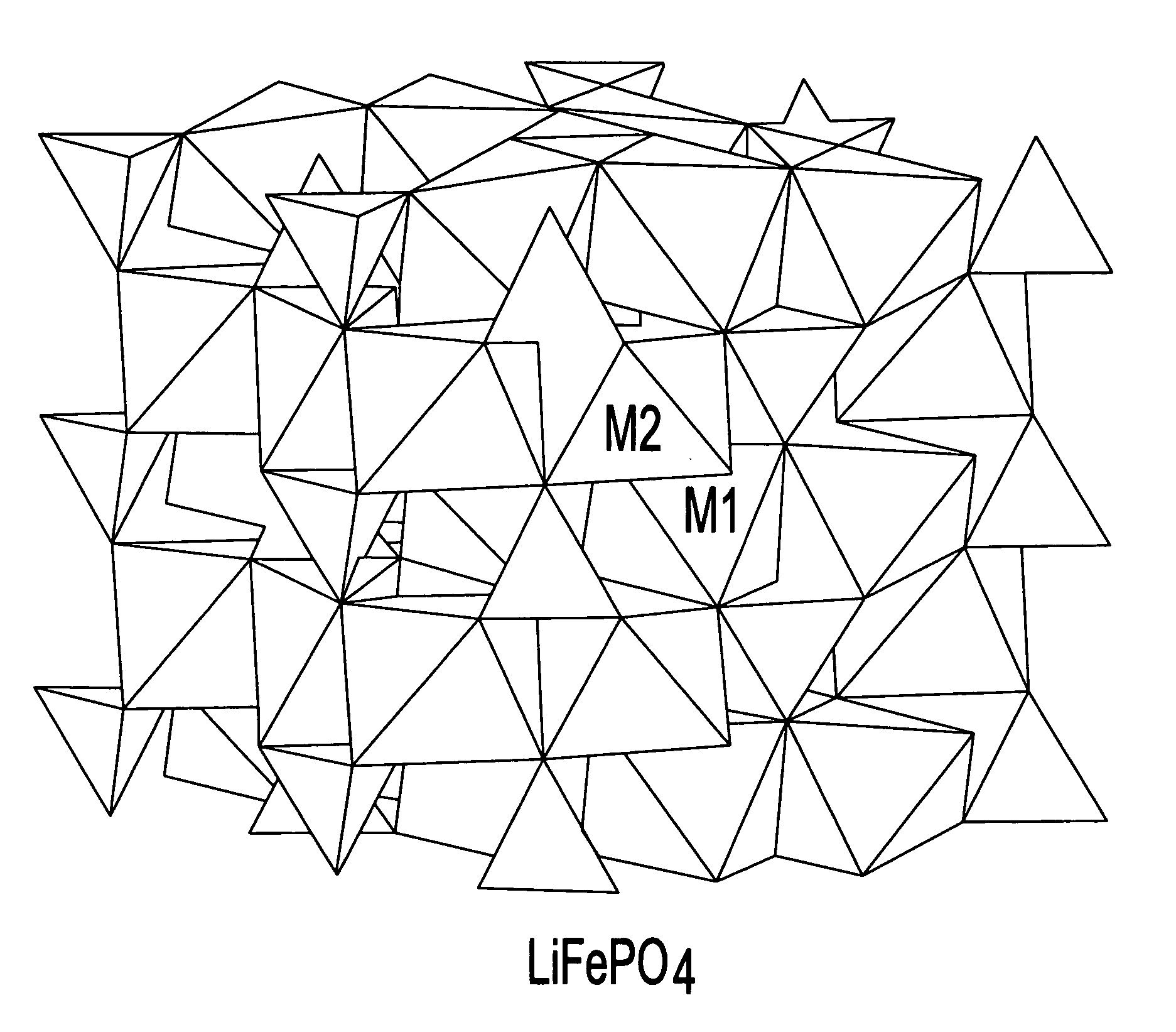Electrode materials for electrochemical cells
a technology of electrochemical cells and electrodes, applied in the field of electrochemical materials, can solve the problems of limiting the use of electrochemical devices, poor storage and transportation properties, and low electronic conductivity
- Summary
- Abstract
- Description
- Claims
- Application Information
AI Technical Summary
Benefits of technology
Problems solved by technology
Method used
Image
Examples
example 1
[0023]Li1.02Fe0.98PO4 samples were prepared in a two-step fashion by first mixing 0.6010 g Li2CO3 (Alfa, 99.0+%), 2.8112 g FeC2O42H2O (Alfa, 99.999%) and 1.8340 g NH4H2PO4 (Aldrich 99.99+%). The powders were mixed in a jar mill for 1 hour utilizing acetone as lubricant. The acetone was evaporated away under a flow of N2 at room temperature. The resulting intimately mixed powder was then placed in a nickel combustion boat, and subsequently heated under N2 for 12 hours at 350° C. in a tube furnace. The furnace-cooled reaction mixture was then reground via jar milling for 1 hour in an acetone slurry. The dried powder was now pelletized, placed in an alumina boat, and then subject to a 14-hour heating step at 800° C. under a flowing atmosphere of 2.5% H2 in N2.
[0024]Conductivity was measured using a four-probe arrangement. A rectangular parallelepiped was cut from each sintered disc using a diamond saw. Nickel foil leads were attached using silver conductive paste (Aldrich) as an adhesi...
example 2
[0025]Li1.035Fe0.965PO4 samples were prepared in a two-step fashion by first mixing 0.6127 g Li2CO3 (Alfa, 99.0+%), 2.7812 g FeC2O42H2O (Alfa, 99.999%) and 1.8428 g NH4H2PO4 (Aldrich 99.99+%). The powders were mixed in a jar mill for 1 hour utilizing acetone as lubricant. The acetone was evaporated away under a flow of N2 at room temperature. The resulting intimately mixed powder was then placed in a nickel combustion boat, and subsequently heated under N2 for 12 hours at 350° C. in a tube furnace. The furnace-cooled reaction mixture when then reground via jar milling for 1 hour in an acetone slurry. The dried powder was now pelletized, placed in an alumina boat, and then subjected to a 14-hour heating step at 800° C. under a flowing atmosphere of 2.5% H2 in N2.
[0026]Conductivity was measured using a four-probe arrangement. A rectangular parallelepiped was cut from each sintered disc using a diamond saw. Nickel foil leads were attached using silver conductive paste (Aldrich) as an a...
example 3
[0027]Li1.05Fe0.95PO4 samples were prepared in a two-step fashion by first mixing 0.6245 g Li2CO3 (Alfa, 99.0+%), 2.7509 g FeC2O42H2O (Alfa, 99.999%) and 1.8516 g NH4H2PO4 (Aldrich 99.99+%). The powders were mixed in a jar mill for 1 hour utilizing acetone as a lubricant. The acetone was evaporated away under a flow of N2 at room temperature. The resulting intimately mixed powder was then placed in a nickel combustion boat, and subsequently heated under N2 for 12 hours at 350° C. in a tube furnace. The furnace-cooled reaction mixture was then reground via jar milling for 1 hour in an acetone slurry. The dried powder was now pelletized, placed in an alumina boat, and then subjected to a 14-hour step at 800° C. under a flowing atmosphere of 2.5% H2 in N2.
[0028]Conductivity was measured using a four-probe arrangement. A rectangular parallelepiped was cut from each sintered disc using a diamond saw. Nickel foil leads were attached using silver conductive paste (Aldrich) as an adhesive. ...
PUM
 Login to View More
Login to View More Abstract
Description
Claims
Application Information
 Login to View More
Login to View More - R&D
- Intellectual Property
- Life Sciences
- Materials
- Tech Scout
- Unparalleled Data Quality
- Higher Quality Content
- 60% Fewer Hallucinations
Browse by: Latest US Patents, China's latest patents, Technical Efficacy Thesaurus, Application Domain, Technology Topic, Popular Technical Reports.
© 2025 PatSnap. All rights reserved.Legal|Privacy policy|Modern Slavery Act Transparency Statement|Sitemap|About US| Contact US: help@patsnap.com



